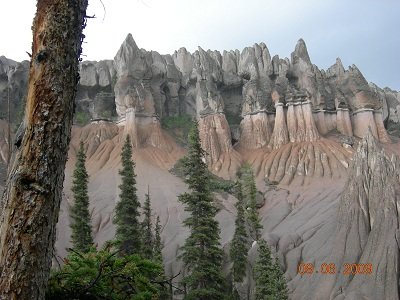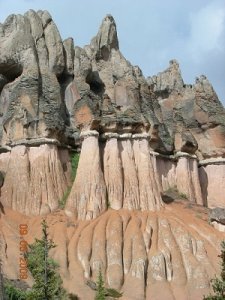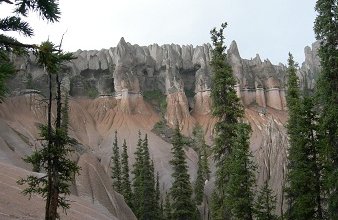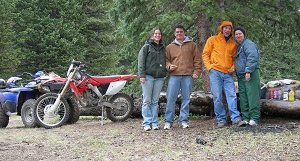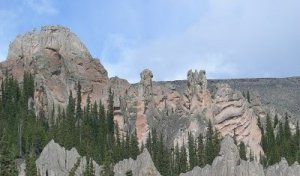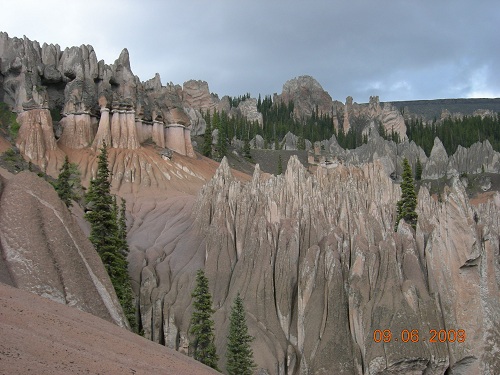|
Wheeler Geological Area
Located high in the La Garita Mountain Range in Southern Colorado lies 640 acres of a haunting landscape known as Wheeler Geological Area. Wheeler Geological Area is located in the Rio Grande National Forest just a few miles before the town of Creede, Colorado.
Formation Wheeler was formed when the area was very active with volcanoes. The rock in this area is a moderately coarse volcanic tuff. The debris was blown into the air from volcanic vents and settled at what is today Wheeler Geological Area. The individual particles ranged in size from dust flakes to blocks two or three feet across. As this area was never firmly compacted it easily crumbles with any external force such as rain and wind. Over many years rains have eroded much of the finer debris leaving the unique features we see today. The large blocks take more time to erode so they have become “caps” for the material below them. With a capstone in place the surrounding material is washed away, forming the sharp spires. When a capstone does deteriorate the spire will continue to erode until a new capstone is uncovered, starting the process again. Time and the elements are against the area as the existing spires and pinnacles slowly erode away.
Getting there The trailhead for Wheeler is about 7 miles southeast of Creede on Colorado 149. Take the Pool Table Road and go about 10 miles to Hanson’s Mill. This is where the two-wheel drive road ends and you must either have a 4WD vehicle, ATV, horse, or plan to walk to Wheeler Geological Area. Walking or Horses Walking the trail or taking horses is a great, peaceful way to enjoy the scenery. It is a 16 mile round trip hike through beautiful meadows, creeks, and trees. The trail starts at about 10,800 feet and rises to almost 12,000 feet at Wheeler. Most of the trail is away from the 4 wheel drive road so you will not be bothered by vehicle noise; however, there are a few areas where the two trails meet and share the same path. This is not a big deal as the vehicles are going very slow due to the rough road.
Four-wheeling The 4WD road also leaves from Hanson’s Mill. It is 14 miles round trip but can take as long as or longer than the hike as the road is extremely rough and very slow going. Close to Wheeler the road narrows and twists through the trees. This road often has deep eroded grooves which can make driving a vehicle a challenge. The road is often impassable when wet and is closed to vehicles in the spring. Also keep this in mind if it has been raining in the area. The entire road is well marked with signs to help get you there. Most of the road is relatively level except where it crosses Trujillo Creek and the Canyon Fernandez drainage. There are no bridges, so just drive though the water. If you have an ATV or want to rent one, I would highly recommend them on this road over a vehicle as it will be much smoother and faster. A beginner on the ATV could handle this trip as it is mostly level road. My family has visited Wheeler several times on ATV’s.
The road dead ends so you don’t have to worry about passing Wheeler, but the only way to see the actual formations is to walk the last half mile to them. This walk is partly uphill and can be tiring but is well worth the effort. When you are walking to the formations take the upward fork so you can have a magnificent view from the top. The lower fork takes you to the bottom of the formation which is still pretty but nothing like the top! As you slowly travel the road or walk into Wheeler Geological Area take the time to stop and admire the beauty. It is a great idea to bring your camera as well as binoculars to look for elk and other wild animals. National Monument or Not? In 1907, Frank Spencer, the supervisor of the Rio Grande National Forest, had been instructed to identify areas that might be worthy of becoming a national monument. He had heard rumors of a hidden place in the La Garita Mountain which the Utes referred to as the “The Sandstones.” He began searching for what is today Wheeler Geological Area. After finding this unique area, Spencer traveled to Washington to push for making this area a national monument. On December 7, 1908, President Roosevelt proclaimed Wheeler National Monument. It was named in honor of Captain George Wheeler who led the War Department’s surveying team through Colorado.
Wheeler Geological Area was on National Forest Land so the Forest Service managed the area. It was recommended that a good road be built to the area so tourists could see it. This suggestion was not followed and the only way to view Wheeler Geological Area was by foot. After World War I a horse trail was developed complete with a cabin, corral, and picnic area. With the invention of the automobile and no road, very few visitors ever saw the unique formations. The park service was not interesting in building a road so the local people of Creede pushed for building a road. With a lack of money this road never materialized. In 1944, M.R. Tillotson, director of Region Three of the National Park Service, visited Wheeler Geological Area. He did not find Wheeler unattractive but was much more impressed with the ride into the monument than the formations themselves. He felt that Wheeler was not outstanding enough to be considered a National Monument and urged that it be returned to National Forest. So on August 3, 1950, only 43 years after becoming a National Monument, Wheeler was changed back to a National Forest area and today we have Wheeler Geological Area.
Return to Top of Wheeler Geological Area
|





